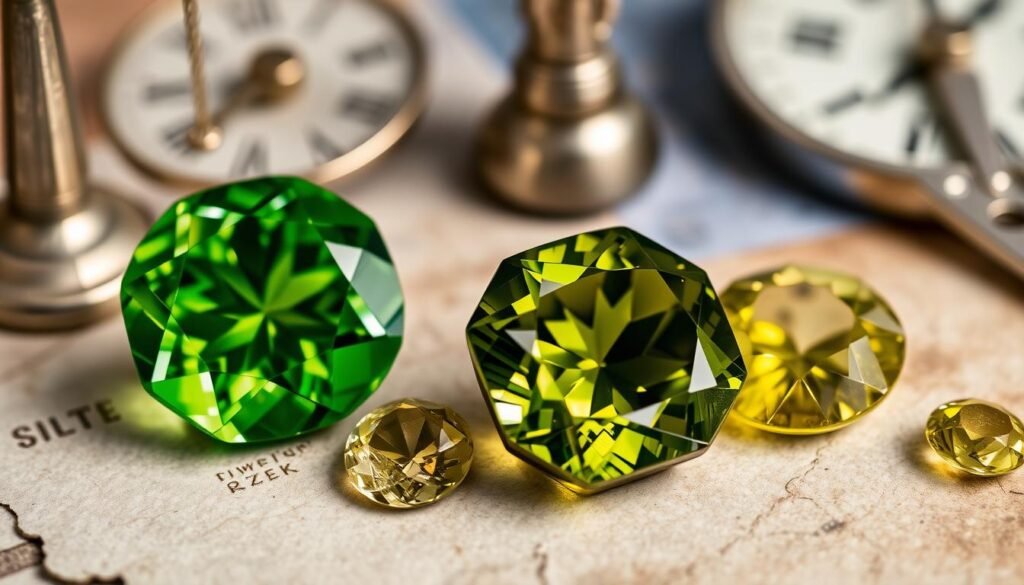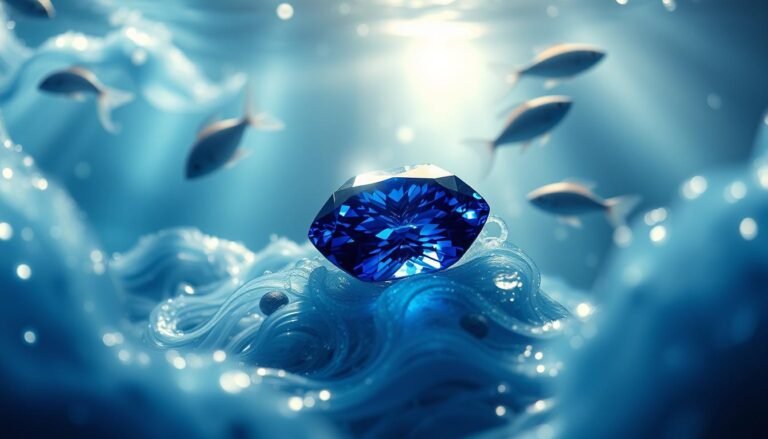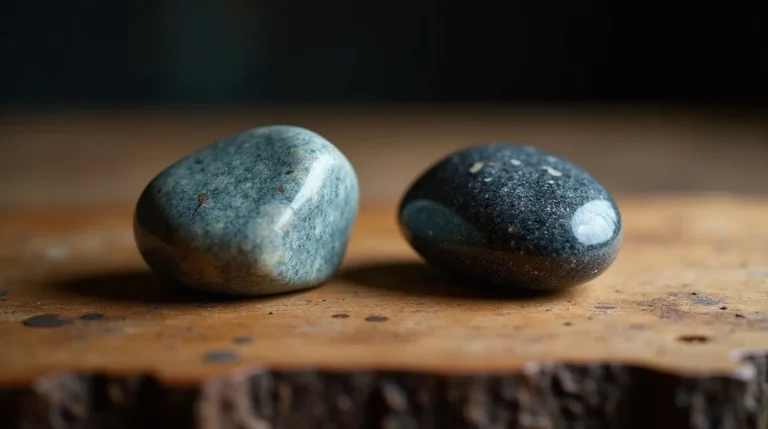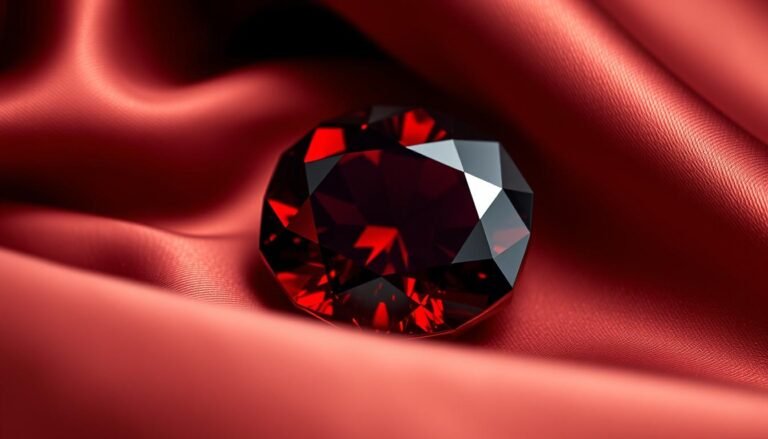Did you know peridots are quite durable, with a hardness of 6.5 to 7 on the Mohs scale? This makes them perfect for many jewelry pieces. Prasiolite, or green amethyst, also has a hardness of 7. Both gemstones are loved for their unique beauty and charm.
In this guide, we’ll explore peridots and prasiolite in detail. We’ll look at their origins, characteristics, and uses in jewelry. Whether you’re a gemstone collector or just curious, this comparison will help you choose your next piece of jewelry.
Get ready to explore the bright, green colors of peridots and prasiolite. Find out which gemstone fits your style best. Let’s discover what makes these green gems so special in the world of jewelry.
Introduction to Green Gemstones
Green gemstones have fascinated people for centuries. They come from the earth’s green colors, bringing nature’s beauty to us. Peridot and prasiolite are two of the most captivating green gems, each with its own charm.
The Allure of Nature’s Verdant Hues
Green gemstones are judged by their color, which includes hue, tone, and saturation. The purest green colors are the most sought after and pricey. Medium-dark tones are the most vibrant and pleasing to the eye.
Clarity is also key. In lighter stones, flaws are more obvious. But, darker gems can hide these imperfections better.
Peridot and Prasiolite: Shades of Emerald Splendor
Peridot and prasiolite, also known as green amethyst, are connected to emerald’s colors. Yet, they have different origins, properties, and spiritual meanings. Learning about peridot and prasiolite reveals their unique qualities as natural wonders.

What is Peridot?
Origin and Formation
Peridots are famous for their bright green color, from light yellowish-green to deep olive green. These stunning gemstones are part of the mineral olivine. They form deep in the Earth’s mantle and are brought up by volcanic activity.
Places like Arizona, Myanmar, and Pakistan are known for their peridot mines. These green gems are found in igneous and metamorphic rocks.
Vivid Green Hues
Peridots are loved for their eye-catching green colors. This makes them a top pick for jewelry and decorations. The green color comes from iron in the olivine mineral.
The intensity of the green depends on the iron amount. This special color makes peridots a timeless and sought-after green gemstone.

What is Prasiolite?
Prasiolite, also known as “green amethyst,” is a type of quartz. It has calming, green colors. Unlike peridot, prasiolite gets its green color through a special process.
An Amethyst Transformation
Prasiolite’s green colors come from heating purple amethyst quartz. This heat changes the crystal’s structure. It turns the purple into soft, green shades, from pale mint to olive.
This process makes prasiolite more affordable than other green gemstones. It’s now popular in jewelry and among collectors.

Prasiolite is mostly silicon dioxide (SiO2), like other quartz types. It’s hard, with a Mohs rating of 7. This makes it durable for jewelry. Its green colors are eye-catching in rings, pendants, or earrings.
Color Comparison
Green gemstones like peridot and prasiolite have their own special colors. Peridots are known for their bright, natural olive greens. These colors can range from light yellowish-green to deep, earthy tones. This vibrant color comes from iron in the gemstone.
Prasiolite, on the other hand, gets its green from heating amethyst. This process makes the gemstone look softer and more pastel-like. The result is a calming green that reminds you of green meadows or quiet forests.
The way these gemstones get their colors makes them unique. Peridot’s bold green is great for those who want a striking gemstone. Prasiolite’s softer green is better for delicate, elegant jewelry. So, the choice between peridot and prasiolite depends on what you like best.

Hardness and Durability
Hardness and durability are key when choosing gemstones. Peridots and prasiolite are good for jewelry because they are hard. But, peridots need a bit more care because they are softer.
Peridots are 6.5 to 7 on the Mohs scale. Prasiolite is a 7, making it more durable. This means prasiolite can handle scratches and chips better.
Prasiolite’s hardness makes it easier to care for. It has a Mohs rating of 7. It also has a special crystal structure and a certain density.
Prasiolite can look blue-green or yellowish olive-green. It doesn’t break easily but can show a special fracture. Its color is white, and it might glow under certain lights.
The Mohs Scale measures gemstone hardness. Diamonds and rubies are almost as hard as 10. But, softer stones like amber are closer to 1.
Prasiolite is more durable than peridot, needing less care. Yet, both are beautiful and can last a long time in your jewelry.

Brilliance and Luster
Peridot and prasiolite have their own special sparkle. Peridots shine brightly with a fiery glow. This is because of their high refractive index.
Prasiolite also shines, but in a more subtle way. It has a soft, understated glow. This is different from peridot’s bold sparkle.
Peridot’s Fiery Sparkle
Peridots are known for their bright, lively shine. Their high refractive index makes them sparkle. This peridot brilliance and peridot luster make them stand out.
Their gemstone sparkle grabs your attention. It adds to their allure.
Prasiolite’s Subtle Radiance
Prasiolite has a softer, more subtle shine. It has a glassy, smooth look. This complements its soft green color.
Its gemstone radiance is not as bold as peridot’s. But it still adds elegance to prasiolite.

Both peridot and prasiolite have a glassy shine. But their brilliance and luster are different. Peridots shine brightly, while prasiolite glows softly.
Knowing how each stone shines helps us see their beauty. It shows us their unique qualities.
Rarity and Availability
In the world of rare gemstones, peridot and prasiolite have their own tales. Peridot is famous for its bright olive-green color. But, finding large, high-quality peridots is hard, making them more valuable.
Prasiolite, a greenish-yellow quartz, is easier to find. It comes in many sizes and shapes, appealing to many. Yet, natural prasiolite is still a semi-precious gem, with its own rarity.
The rarity of peridot compared to prasiolite affects their prices. This difference makes their market interesting. Each green gem has its own charm and appeal.
| Gemstone | Rarity | Availability |
|---|---|---|
| Peridot | Larger, high-quality specimens can be rare | Widely available in various sizes and shapes |
| Prasiolite | Natural prasiolite is considered semi-precious | More widely available than natural peridot |
Whether you love peridot’s bold colors or prasiolite’s soft shades, knowing their rarity helps. It guides you in choosing these beautiful green gemstones.

prasiolite or peridot: Metaphysical Properties
Peridot and prasiolite have special meanings in the spiritual world. Peridots are linked to energy, wealth, and protection. They help grow and keep well-being.
Peridot’s Symbolism
Peridot has a long history and deep spiritual value. It cleanses and balances the aura, bringing emotional and mental clarity. It’s also tied to the sun, symbolizing warmth, creativity, and positivity.
Prasiolite’s Spiritual Associations
Prasiolite is connected to calm and growth. It helps with spiritual development, healing, and balancing. It’s especially good for the heart, opening to love and self-acceptance.
Choose between peridot’s lively energy or prasiolite’s calming power. Both green gemstones can enhance your spiritual path. Discover which one fits your journey best.

Jewelery Applications
Peridot and prasiolite are both great for green gemstone jewelry. Peridot is known for its bright olive-green color and spark. It’s perfect for rings, necklaces, and earrings, adding a pop of color to any outfit.
Prasiolite, on the other hand, has softer, pastel green tones. It’s often seen in rings, pendants, and bracelets. This gemstone brings elegance and a sense of calm, making it special for those who value spiritual connections.
| Peridot Jewelry | Prasiolite Jewelry |
|---|---|
|
|
Whether you love the bold colors of peridot or the soft look of prasiolite, there’s a lot to choose from. These green gemstones let you show off your style and connect with nature through beautiful jewelry.

Caring for Your Gemstones
Proper care is key to keeping your peridot and prasiolite jewelry looking great. Peridots need a bit more care because they are softer than prasiolites.
To keep your gemstones shining, follow these easy tips:
- Clean your gemstones gently with a soft, damp cloth. Avoid harsh chemicals or ultrasonic cleaners that can harm the stones.
- Keep your jewelry in a cool, dry spot. Stay away from direct sunlight and sudden temperature changes to prevent damage.
- Be careful when handling your gemstones. They can scratch or chip easily. Don’t wear your jewelry during risky activities.
By following these basic care and maintenance steps, your peridot and prasiolite jewelry will stay beautiful for many years.
Remember, each gemstone is unique. So, adjust your gemstone care to fit your peridot and prasiolite pieces’ needs. A little extra care will help keep their natural beauty intact.
Ethical Sourcing and Sustainability
More and more people want to know where their jewelry comes from. This is especially true for gemstones like peridot and prasiolite. Knowing how these stones are mined can really make a difference.
The path from mine to market for colored stones is not as clear as it is for diamonds. The Kimberley Process has helped with conflict diamonds, but there’s no similar system for colored stones. So, it’s key to buy from companies that care about where their stones come from.
Brands like Brilliant Earth are leading the way in making the gemstone industry more open. They work with trusted suppliers and mining communities. This ensures that the gemstones in their jewelry are mined and processed responsibly.
| Responsible Gemstone Sourcing | Traditional Gemstone Supply Chain |
|---|---|
|
|
Choosing jewelry from brands that focus on ethical sourcing is a big step. It helps support a fair and open gemstone industry. This not only keeps these beautiful stones available but also helps the communities that depend on them.
Price and Value Considerations
In the world of gemstones, prasiolite and peridot have different prices and values. Prasiolite, a green quartz, is often cheaper because of its treatment. This makes it a favorite for those watching their budget. But, the value of both stones depends on their color, cut, clarity, and any treatments or synthetics.
Peridots are prized for their bright olive-green color. They can be more expensive, especially for big, high-quality ones. Prasiolite, on the other hand, is a more affordable choice for those wanting a green gemstone. Prices for prasiolite start at $0.50 per carat and can go up based on size, shape, and color.
Prasiolite is a good deal because it’s cheaper than faceted stones. It’s perfect for jewelry, especially in silver designs. But, beware of synthetic green quartz sold as real prasiolite. It might look more vibrant than natural stones.

| Gemstone | Price Range | Factors Affecting Value |
|---|---|---|
| Peridot | $50 – $500 per carat | Color, size, cut, clarity |
| Prasiolite | $0.50 – $150 per carat | Color intensity, size, shape, clarity |
Choosing between prasiolite and peridot depends on what you like, your budget, and the look you want for your jewelry. Knowing the price and value of these green gemstones helps you make a choice that fits your needs and taste.
Where to Buy Authentic Gemstones
When looking for peridot, prasiolite, or other gemstones, it’s key to buy from trusted sources. Look for established jewelry stores, online shops, and gemstone dealers known for their honesty. These places ensure you get real, quality stones.
To find real gemstones, do your homework, read reviews, and check where the stones come from. This way, you can avoid fake or misrepresented items. Here are some tips for buying genuine gemstones:
- Check out well-known jewelry stores, both online and in person, known for real gemstones.
- Buy from gemstone dealers who openly share the origin and treatment of their stones.
- Look for certifications or third-party checks that prove the gemstones are real.
- Be cautious of very cheap deals, as they might mean the gemstones are not genuine.
By doing your research and buying from trusted sources, you can be sure the peridot, prasiolite, or other gemstones are real and top-notch. This not only means you get a beautiful gem but also peace of mind knowing you made a smart choice.
| Retailer | Gemstone Offerings | Authenticity Assurance |
|---|---|---|
| Gemstone Emporium | Peridot, Prasiolite, Amethyst, Sapphire | Third-party certification, ethical sourcing |
| Jewelry Artisans | Peridot, Prasiolite, Citrine, Ruby | Gemological laboratory testing, lifetime warranty |
| Gem Cove | Prasiolite, Emerald, Topaz, Tourmaline | Strict supplier vetting, money-back guarantee |
Conclusion
Peridots and green amethysts (prasiolite) are both beautiful in their own way. They have unique meanings and appeal to different tastes. Your choice depends on what you like, how much you want to spend, and the message you want to send.
Peridots have a bright, olive green color and shine brightly. They’re perfect for those who love bold, eye-catching jewelry. On the other hand, prasiolite has softer, pastel greens and a gentle glow. It’s ideal for those who prefer a more subtle look.
In the end, both peridot and prasiolite are great choices for your jewelry. They bring a timeless beauty and meaning to your outfits. Choose the one that fits your style and personality, and enjoy the unique charm they add.







